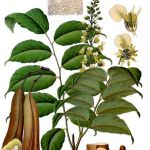| Common Name: |
Bálsamo |
| Other Names: |
Tolu Balsam, Balsam of Tolu, Balsam Tree, Peruvian Balsam |
| Botanical Name: |
Myroxylon balsamum syn. M. toluiferum |
| Genus: |
Myroxylon |
| Family: |
Papilionaceae |
| Native Location: |
Mexico, Panama, and Peru; widely naturalized. |
| Cultivation: |
Well-drained soil with added sand and leaf mold, in sun, with ample water when in growth; M. balsamum var. pereirae tolerates alkaline and poor soils. Balsam trees are resilient, tolerating heavy tapping and often reaching 100 years old. |
| Propagation: |
By seed sown when ripe; by semi-ripe cuttings in late summer. |
| Harvest: |
Oleo-resin is collected at any time of the year, but mostly during the dry season, by wounding the bark; it is used raw, or processed into extracts, oils, syrups, and tinctures. Oil is distilled from oleo-resin. Seed are collected when ripe, and used whole. |
| Height: |
12-15m (40-50ft) |
| Width: |
5-10m (15-30ft) |
| Hardiness: |
Z8 |
| Parts Used: |
Seeds, oleo-resin, oil, bark |
| Properties: |
A sweet, acid-tasting, aromatic herb that acts as an antiseptic and stimulating expectorant. |
| Medicinal Uses: |
Mainly as a pleasant-tasting ingredient in friar's balsam and cough mixtures; also as a base for lozenges (oleo-resin).
To treat hemorrhoids, coughs, colds, fever, and wounds. |
| Possible Side Effects: |
Balsam of Peru's side effects include skin irritation and sun sensitivity. |
| Drug Interactions: |
| Taking Balsam of Peru with these drugs may cause or increase kidney damage: |
| Etodolac, (Lodine, Utradol) |
Ibuprofen, (Advil, Motrin) |
Indomethacin, (Indocin, Novo-Methacin) |
| Ketoprofen, (Orudis, Rhodis) |
Ketorolac, (Acular, Toradol) |
Metformin, (Glucophage, Riomet) |
|
| Culinary Uses: |
Seeds of M. balsamum var. perierae are added to aguardiente (Guatemala). |
| Economic Uses: |
Resin is used in commercial food flavoring (mainly for chewing gum, ice cream, candy, soft drinks, and bakery products). Oil is used in perfumery. |
| Bibliography: |
The Encyclopedia of Herbs by Deni Bown Copyright © 1995,2001 Dorling Kindersley Limited pg. 285
The Essential Herb-Drug-Vitamin Interaction Guide by Geo. T. Grossberg,MD and Barry Fox,PhD Copyright©2007 Barry Fox,PhD. Pg 56 |

